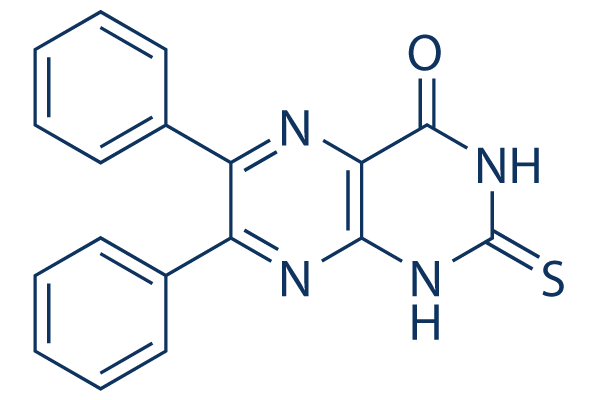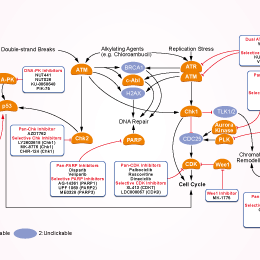
- Bioactive Compounds
- By Signaling Pathways
- PI3K/Akt/mTOR
- Epigenetics
- Methylation
- Immunology & Inflammation
- Protein Tyrosine Kinase
- Angiogenesis
- Apoptosis
- Autophagy
- ER stress & UPR
- JAK/STAT
- MAPK
- Cytoskeletal Signaling
- Cell Cycle
- TGF-beta/Smad
- DNA Damage/DNA Repair
- Compound Libraries
- Popular Compound Libraries
- Customize Library
- Clinical and FDA-approved Related
- Bioactive Compound Libraries
- Inhibitor Related
- Natural Product Related
- Metabolism Related
- Cell Death Related
- By Signaling Pathway
- By Disease
- Anti-infection and Antiviral Related
- Neuronal and Immunology Related
- Fragment and Covalent Related
- FDA-approved Drug Library
- FDA-approved & Passed Phase I Drug Library
- Preclinical/Clinical Compound Library
- Bioactive Compound Library-I
- Bioactive Compound Library-Ⅱ
- Kinase Inhibitor Library
- Express-Pick Library
- Natural Product Library
- Human Endogenous Metabolite Compound Library
- Alkaloid Compound LibraryNew
- Angiogenesis Related compound Library
- Anti-Aging Compound Library
- Anti-alzheimer Disease Compound Library
- Antibiotics compound Library
- Anti-cancer Compound Library
- Anti-cancer Compound Library-Ⅱ
- Anti-cancer Metabolism Compound Library
- Anti-Cardiovascular Disease Compound Library
- Anti-diabetic Compound Library
- Anti-infection Compound Library
- Antioxidant Compound Library
- Anti-parasitic Compound Library
- Antiviral Compound Library
- Apoptosis Compound Library
- Autophagy Compound Library
- Calcium Channel Blocker LibraryNew
- Cambridge Cancer Compound Library
- Carbohydrate Metabolism Compound LibraryNew
- Cell Cycle compound library
- CNS-Penetrant Compound Library
- Covalent Inhibitor Library
- Cytokine Inhibitor LibraryNew
- Cytoskeletal Signaling Pathway Compound Library
- DNA Damage/DNA Repair compound Library
- Drug-like Compound Library
- Endoplasmic Reticulum Stress Compound Library
- Epigenetics Compound Library
- Exosome Secretion Related Compound LibraryNew
- FDA-approved Anticancer Drug LibraryNew
- Ferroptosis Compound Library
- Flavonoid Compound Library
- Fragment Library
- Glutamine Metabolism Compound Library
- Glycolysis Compound Library
- GPCR Compound Library
- Gut Microbial Metabolite Library
- HIF-1 Signaling Pathway Compound Library
- Highly Selective Inhibitor Library
- Histone modification compound library
- HTS Library for Drug Discovery
- Human Hormone Related Compound LibraryNew
- Human Transcription Factor Compound LibraryNew
- Immunology/Inflammation Compound Library
- Inhibitor Library
- Ion Channel Ligand Library
- JAK/STAT compound library
- Lipid Metabolism Compound LibraryNew
- Macrocyclic Compound Library
- MAPK Inhibitor Library
- Medicine Food Homology Compound Library
- Metabolism Compound Library
- Methylation Compound Library
- Mouse Metabolite Compound LibraryNew
- Natural Organic Compound Library
- Neuronal Signaling Compound Library
- NF-κB Signaling Compound Library
- Nucleoside Analogue Library
- Obesity Compound Library
- Oxidative Stress Compound LibraryNew
- Plant Extract Library
- Phenotypic Screening Library
- PI3K/Akt Inhibitor Library
- Protease Inhibitor Library
- Protein-protein Interaction Inhibitor Library
- Pyroptosis Compound Library
- Small Molecule Immuno-Oncology Compound Library
- Mitochondria-Targeted Compound LibraryNew
- Stem Cell Differentiation Compound LibraryNew
- Stem Cell Signaling Compound Library
- Natural Phenol Compound LibraryNew
- Natural Terpenoid Compound LibraryNew
- TGF-beta/Smad compound library
- Traditional Chinese Medicine Library
- Tyrosine Kinase Inhibitor Library
- Ubiquitination Compound Library
-
Cherry Picking
You can personalize your library with chemicals from within Selleck's inventory. Build the right library for your research endeavors by choosing from compounds in all of our available libraries.
Please contact us at [email protected] to customize your library.
You could select:
- Antibodies
- Bioreagents
- qPCR
- 2x SYBR Green qPCR Master Mix
- 2x SYBR Green qPCR Master Mix(Low ROX)
- 2x SYBR Green qPCR Master Mix(High ROX)
- Protein Assay
- Protein A/G Magnetic Beads for IP
- Anti-Flag magnetic beads
- Anti-Flag Affinity Gel
- Anti-Myc magnetic beads
- Anti-HA magnetic beads
- Magnetic Separator
- Poly DYKDDDDK Tag Peptide lyophilized powder
- Protease Inhibitor Cocktail
- Protease Inhibitor Cocktail (EDTA-Free, 100X in DMSO)
- Phosphatase Inhibitor Cocktail (2 Tubes, 100X)
- Cell Biology
- Cell Counting Kit-8 (CCK-8)
- Animal Experiment
- Mouse Direct PCR Kit (For Genotyping)
- New Products
- Contact Us
SCR7
SCR7 is a specific DNA Ligase IV inhibitor, which blocks nonhomologous end-joining (NHEJ). It increases the efficiency of HDR-mediated genome editing up to 19-fold using CRISPR/Cas9 in mammalian cells and mouse embryos.

SCR7 Chemical Structure
CAS No. 14892-97-8
Purity & Quality Control
Batch:
Purity:
99.99%
99.99
SCR7 Related Products
| Related Targets | tRNA synthetase RdRp DNA synthesis helicase ribonucleotide reductase | Click to Expand |
|---|---|---|
| Related Products | Pidnarulex (CX-5461) Favipiravir (T-705) RK-33 Carmofur Triapine (3-AP) B02 BMH-21 YK-4-279 Bergapten Tegafur (FT-207) Azaguanine-8 Halofuginone Adenine HCl Mizoribine Cyclocytidine HCl Thymidine APX-3330 Nedaplatin 6-Thio-dG Flupirtine maleate JH-RE-06 Pritelivir (BAY 57-1293) TK216 Amenamevir Madrasin Tubercidin BC-LI-0186 CRT0044876 PFM01 Adenine ML216 | Click to Expand |
| Related Compound Libraries | FDA-approved Drug Library Natural Product Library Apoptosis Compound Library DNA Damage/DNA Repair compound Library Cell Cycle compound library | Click to Expand |
Signaling Pathway
Biological Activity
| Description | SCR7 is a specific DNA Ligase IV inhibitor, which blocks nonhomologous end-joining (NHEJ). It increases the efficiency of HDR-mediated genome editing up to 19-fold using CRISPR/Cas9 in mammalian cells and mouse embryos. | |
|---|---|---|
| Targets |
|
| In vitro | ||||
| In vitro | SCR7 effectively inhibits the formation of multimers at 200 μM and above. SCR7 successfully inhibits cell proliferation of MCF7, A549, HeLa, T47D, A2780, HT1080, and Nalm6 with IC50 of 40, 34, 44, 8.5, 120, 10, and 50 μM, respectively.[1] SCR7 suppresses the NHEJ repair of CRISPR-Cas9-induced DSBs.[2]SCR7 increases the efficiency of HDR-mediated genome editing up to 19-fold using CRISPR/Cas9 in mammalian cells and mouse embryos[3]. |
|||
|---|---|---|---|---|
| Kinase Assay | Complementation of SCR7 Inhibition with Purified Ligase IV | |||
| Complementation experiment is carried out by adding increasing concentrations of purified Ligase IV/XRCC4 complex (30, 60, and 120 fmol) along with the oligomeric DNA substrates (5’ compatible and 5’-5’ noncompatible ends) to the SCR7-treatedextracts. Reactions are incubated for 2 h at 25℃. The reaction products are then resolved on 8% denaturing PAGE. The gel is dried and exposed and the signal is detected with a PhosphorImager and analyzed with Multi Gauge (V3.0) software. | ||||
| Cell Research | Cell lines | MCF7, CEM, HeLa, A549, HT1080, A2780, T47D, Nalm6, N114 and K562 cells | ||
| Concentrations | 250 μM | |||
| Incubation Time | 48 h | |||
| Method | Cell proliferation of cancer cells are determined by MTT and trypan blue assays. Briefly, MCF7, CEM, HeLa, A549, HT1080, A2780, T47D, Nalm6, N114 and K562 cells are grown in presence of SCR7 (10, 50, 100, and 250 μM) for 24 or 48 h, and subjected to MTT or trypan blue assays. Each experiment is repeated a minimum of three independent times. |
|||
| In Vivo | ||
| In vivo | SCR7 treatment (10 mg/kg, i.m.) significantly reduces breast adenocarcinoma-induced tumor, and exhibits 4-fold increase in lifespan compared with control group. However, in Swiss albino mice with Dalton’s lymphoma tumor model, SCR7 (20 mg/kg, i.p.) exhibits neither tumor regression nor increase in lifespan. In BALB/c mice, SCR7 (20 mg/kg, i.p.) significantly enhances the cytotoxic effects of radiation, VP-16213 and 3-Aminobenzamide on tumor derived from Dalton’s lymphoma (DLA) cells.[1] |
|
|---|---|---|
| Animal Research | Animal Models | BALB/c mice |
| Dosages | 10 mg/kg | |
| Administration | i.m. | |
| NCT Number | Recruitment | Conditions | Sponsor/Collaborators | Start Date | Phases |
|---|---|---|---|---|---|
| NCT03941483 | Completed | Acute Kidney Injury (AKI) |
Astellas Pharma Inc |
November 1 2019 | Phase 2 |
Chemical Information & Solubility
| Molecular Weight | 332.38 | Formula | C18H12N4OS |
| CAS No. | 14892-97-8 | SDF | Download SCR7 SDF |
| Smiles | C1=CC=C(C=C1)C2=NC3=C(NC(=S)NC3=O)N=C2C4=CC=CC=C4 | ||
| Storage (From the date of receipt) | |||
|
In vitro |
DMSO : 66 mg/mL ( (198.56 mM) Moisture-absorbing DMSO reduces solubility. Please use fresh DMSO.) Ethanol : 23 mg/mL Water : Insoluble |
Molecular Weight Calculator |
|
In vivo Add solvents to the product individually and in order. |
In vivo Formulation Calculator |
||||
Preparing Stock Solutions
Molarity Calculator
In vivo Formulation Calculator (Clear solution)
Step 1: Enter information below (Recommended: An additional animal making an allowance for loss during the experiment)
mg/kg
g
μL
Step 2: Enter the in vivo formulation (This is only the calculator, not formulation. Please contact us first if there is no in vivo formulation at the solubility Section.)
% DMSO
%
% Tween 80
% ddH2O
%DMSO
%
Calculation results:
Working concentration: mg/ml;
Method for preparing DMSO master liquid: mg drug pre-dissolved in μL DMSO ( Master liquid concentration mg/mL, Please contact us first if the concentration exceeds the DMSO solubility of the batch of drug. )
Method for preparing in vivo formulation: Take μL DMSO master liquid, next addμL PEG300, mix and clarify, next addμL Tween 80, mix and clarify, next add μL ddH2O, mix and clarify.
Method for preparing in vivo formulation: Take μL DMSO master liquid, next add μL Corn oil, mix and clarify.
Note: 1. Please make sure the liquid is clear before adding the next solvent.
2. Be sure to add the solvent(s) in order. You must ensure that the solution obtained, in the previous addition, is a clear solution before proceeding to add the next solvent. Physical methods such
as vortex, ultrasound or hot water bath can be used to aid dissolving.
Tech Support
Answers to questions you may have can be found in the inhibitor handling instructions. Topics include how to prepare stock solutions, how to store inhibitors, and issues that need special attention for cell-based assays and animal experiments.
Tel: +1-832-582-8158 Ext:3
If you have any other enquiries, please leave a message.
* Indicates a Required Field
Frequently Asked Questions
Question 1:
What should I do if I got precipitate out of solution after a freeze thaw and cannot re-suspend it?
Answer:
Some compounds will precipitate out of solution after freeze/thaw, especially at very high concentration. You can warm it up to 45 degree and sonicate it to help it dissolve, of course, adding more DMSO will help too.
Tags: buy SCR7 | SCR7 supplier | purchase SCR7 | SCR7 cost | SCR7 manufacturer | order SCR7 | SCR7 distributor







































